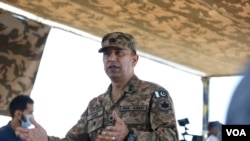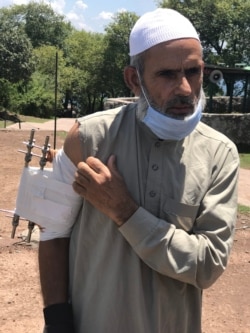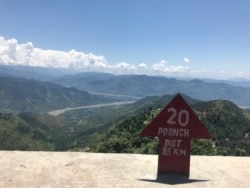Pakistan’s military has rebutted claims it is colluding with close ally China to try to engage rival India in a “two-front” war in the disputed region of Kashmir.
A senior army commander instead blamed Indian border forces Wednesday for escalating tensions along the Line of Control (LoC), which separates Pakistani- and Indian-controlled parts of the Himalayan territory.
Major General Amer Ahsan Nawaz, the top commander of Pakistani troops in Kashmir, claimed that India has so far committed nearly 2,000 violations of a mutual cease-fire in Kashmir this year, targeting mostly civilian populations and inflicting dozens of casualties on them.
The general was briefing a group of reporters the military flew to the Chirikot sector on the 780-kilometer LoC to witness the plight of villagers living along one of the most militarized frontiers in the world.
“There is no grand design of fighting a two-front with Indians as far as we are concerned,” Nawaz said in the interaction arranged on a hilltop post just three kilometers from the LoC and overlooking Indian military positions.
“This is a fear, this is a narrative that the Indians have, and they want to propagate, and they want to create that kind of stimulant in their local dynamics that there is a possibility of a two-front” war, the Pakistani general asserted.
Nawaz was responding to questions about India’s concerns that Pakistan and China, which also controls parts of Kashmir, were “collusively” trying to mount military pressure on India.
Tensions between India and China are at their worst in decades following a clash last month over their disputed border in the Himalayas that killed 20 Indian soldiers. Chinese and Indian troops reportedly remain deployed eyeball-to-eyeball along what is known as the Line of Actual Control in Ladakh.
“As far as the two-front war is concerned, it is a possibility,” General Manoj Mukund Naravane, India’s chief of army staff, was quoted as saying in May.
The military also arranged an interaction with about two dozen villagers in the area, including victims of the border clashes.
“I was asleep on the night of July 3 when Indian forces suddenly started shelling our village. One of the mortars hit the neighboring house, and I also got injured,” Abdul Aziz, who received multiple fractures in his right hand, told reporters.
Other villagers sitting next to the 60-year-old man also shared their woes, with most of them saying they routinely run to underground bunkers near their houses to take refuge from near-daily skirmishes between the two sides.
For its part, India blames Pakistani troops for opening cross-border fire in violation of the 2003 cease-fire. Late Wednesday, Indian officials reportedly accused the Pakistani side of launching “unprovoked” small-arms fire and mortar shells against areas in the district of Poonch.
Pakistan’s tensions with India have plunged to historic lows since last August when Prime Minister Narendra Modi’s Hindu nationalist government stripped semiautonomy from the country’s only Muslim-majority state of Kashmir and divided the region into two union territories.
Indian authorities have since placed the region under tight security and communication restrictions to deter violent protests in reaction to the government’s steps, which it insists will help improve security and facilitate economic development in the violent region.
Pakistan rejected India's moves, saying Kashmir is an internationally recognized dispute under a U.N. Security Council resolution and neither side is allowed to alter the status.
Officials in New Delhi routinely allege that militants from Pakistan try to infiltrate into Indian Kashmir to foment trouble there.
Islamabad denies the charges.
Nawaz on Wednesday questioned Indian claims of infiltration, noting that the Indian military has fenced their side of the LoC, deployed large numbers of troops and established a robust multilayered anti-infiltration surveillance grid, including mines, underground sensors and other modern gadgets.
“You tell me – with all that gadgetry, all those people on the line of control, if people are still infiltrating, then there is a big question mark on what the Indian army is doing?” he said.


